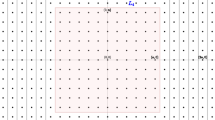Abstract
Let each site of the square lattice \(\mathbb {Z}^2\) be independently assigned one of three states: a trap with probability p, a target with probability q, and open with probability \(1-p-q\), where \(0<p+q<1\). Consider the following game: a token starts at the origin, and two players take turns to move, where a move consists of moving the token from its current site x to either \(x+(0,1)\) or \(x+(1,0)\). A player who moves the token to a trap loses the game immediately, while a player who moves the token to a target wins the game immediately. Is there positive probability that the game is drawn with best play—i.e. that neither player can force a win? This is equivalent to the question of ergodicity of a certain family of elementary one-dimensional probabilistic cellular automata (PCA). These automata have been studied in the contexts of enumeration of directed lattice animals, the golden-mean subshift, and the hard-core model, and their ergodicity has been noted as an open problem by several authors. We prove that these PCA are ergodic, and correspondingly that the game on \(\mathbb {Z}^2\) has no draws. On the other hand, we prove that certain analogous games do exhibit draws for suitable parameter values on various directed graphs in higher dimensions, including an oriented version of the even sublattice of \(\mathbb {Z}^d\) in all \(d\ge 3\). This is proved via a dimension reduction to a hard-core lattice gas in dimension \(d-1\). We show that draws occur whenever the corresponding hard-core model has multiple Gibbs distributions. We conjecture that draws occur also on the standard oriented lattice \(\mathbb {Z}^d\) for \(d\ge 3\), but here our method encounters a fundamental obstacle.











Similar content being viewed by others
References
Balister, P., Bollobás, B., Johnson, J.R., Walters, M.: Random majority percolation. Random Struct. Algorithms 36(3), 315–340 (2010)
Beljaev, J.K., Gromak, J.I., Malyšev, V.A.: Invariant random Boolean fields. Mat. Zametki 6, 555–566 (1969)
Blanca, A., Galvin, D., Randall, D., Tetali., P.: Phase coexistence and slow mixing for the hard-core model on \({\mathbb{Z}}^2\). In: Approximation, Randomization, and Combinatorial Optimization. Algorithms and Techniques, pp. 379–394. Springer (2013)
Basu, R., Holroyd, A.E., Martin, J.B., Wästlund, J.: Trapping games on random boards. Ann. Appl. Probab. 26(6), 3727–3753 (2016)
Bousquet-Mélou, M.: New enumerative results on two-dimensional directed animals. In: Proceedings of the 7th Conference on Formal Power Series and Algebraic Combinatorics (Noisy-le-Grand, 1995), volume 180 of Discrete Mathematics, pp. 73–106 (1998)
Bušić, A., Mairesse, J., Marcovici, I.: Probabilistic cellular automata, invariant measures, and perfect sampling. Adv. Appl. Probab. 45(4), 960–980 (2013)
Conway, J.H.: On numbers and games, 2nd edn. A K Peters Ltd, Natick (2001)
Conway, J.H., Sloane, N.J.A.: Sphere Packings, Lattices and Groups, volume 290 of Grundlehren der Mathematischen Wissenschaften [Fundamental Principles of Mathematical Sciences], 3rd edn. Springer, New York (1999)
Dhar, D.: Exact solution of a directed-site animals-enumeration problem in three dimensions. Phys. Rev. Lett. 51(10), 853–856 (1983)
Dobrushin, R.L.: Existence of a phase transition in the two-dimensional and three-dimensional Ising models. Sov. Phys. Dokl. 10, 111–113 (1965)
Eloranta, K.: Golden mean subshift revised. Research reports, Helsinki University of Technology, Institute of Mathematics (1996)
Gács, P.: Reliable cellular automata with self-organization. J. Stat. Phys. 103(1–2), 45–267 (2001)
Gravner, J., Holroyd, A.E.: Percolation and disorder-resistance in cellular automata. Ann. Probab. 43(4), 1731–1776 (2015)
Galvin, D., Kahn, J.: On phase transition in the hard-core model on \({\mathbb{Z}}^d\). Comb. Probab. Comput. 13(2), 137–164 (2004)
Gray, L.F.: The positive rates problem for attractive nearest neighbor spin systems on Z. Z. Wahrsch. Verw. Gebiete 61(3), 389–404 (1982)
Gray, L.F.: A reader’s guide to P. Gács’s positive rates paper. J. Stat. Phys. 103(1–2), 1–44 (2001)
Heilmann, O.J.: The use of reflection as symmetry operation in connection with Peierls’ argument. Commun. Math. Phys. 36, 91–114 (1974)
Holroyd, A.E., Martin, J.B.: Galton–Watson games (in preparation)
Holley, R.: An ergodic theorem for interacting systems with attractive interactions. Z. Wahrsch. Verw. Gebiete 24, 325–334 (1972)
Holley, R., Stroock, D.: Dual processes and their application to infinite interacting systems. Adv. Math. 32(2), 149–174 (1979)
Kozlov, O., Vasilyev, N.: Reversible Markov chains with local interaction. In: Multicomponent Random Systems, volume 6 of Advanced Probability and Statistics, pp. 451–469. Dekker, New York (1980)
Le Borgne, Y., Marckert, J.-F.: Directed animals and gas models revisited. Electron. J. Comb. 14(1), 71 (2007)
Liggett, T.M.: Survival of discrete time growth models, with applications to oriented percolation. Ann. Appl. Probab. 5(3), 613–636 (1995)
Mairesse, J., Marcovici, I.: Around probabilistic cellular automata. Non-uniform cellular automata. Theor. Comput. Sci. 559, 42–72 (2014)
Mairesse, J., Marcovici, I.: Probabilistic cellular automata and random fields with i.i.d. directions. Ann. Inst. Henri Poincaré Probab. Stat. 50(2), 455–475 (2014)
Mairesse, J., Marcovici, I.: Uniform sampling of subshifts of finite type on grids and trees. Int. J. Found. Comput. Sci. 28(3), 263–287 (2017)
Nagy, B., Strand, R.: A connection between \({\mathbb{Z}}^n\) and generalized triangular grids. In: ISVC 2008, volume 3539 of Lecture Notes in Computer Science, pp. 1157–1166. Springer, Heidelberg (2008)
Runnels, L.K.: Phase transitions of hard sphere lattice gases. Commun. Math. Phys. 40, 37–48 (1975)
Toom, A.L., Vasilyev, N.B., Stavskaya, O.N., Mityushin, L.G., Kurdyumov, G.L., Pirogov, S.A.: Discrete local Markov systems. In: Dobrushin, R.L., Kryukov, V.I., Toom, A.L. (eds.) Stochastic Cellular Systems: Ergodicity, Memory, Morphogenesis, Nonlinear Science, pp. 1–175. Manchester University Press, Manchester (1990)
Vasilyev, N.B.: Bernoulli and Markov stationary measures in discrete local interactions. In: Developments in Statistics, vol. 1, pp. 99–112. Academic Press, New York (1978)
Acknowledgements
JBM was supported by EPSRC Fellowship EP/E060730/1. IM was supported by the Fondation Sciences Mathématiques de Paris. We are grateful to two referees for valuable comments. In particular, the proof of Theorem 2(ii) was prompted by a referee’s observation that such an approach gives a straightforward proof of the \(q=0\) case of Theorem 1.
Author information
Authors and Affiliations
Corresponding author
Rights and permissions
About this article
Cite this article
Holroyd, A.E., Marcovici, I. & Martin, J.B. Percolation games, probabilistic cellular automata, and the hard-core model. Probab. Theory Relat. Fields 174, 1187–1217 (2019). https://doi.org/10.1007/s00440-018-0881-6
Received:
Revised:
Published:
Issue Date:
DOI: https://doi.org/10.1007/s00440-018-0881-6




